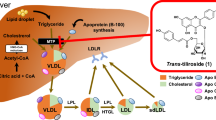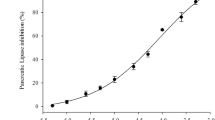Abstract
Recent studies have yielded evidence that plant flavonoids reduce hepatic lipid and apolipoprotein B (apoB) secretion. However, the possible role of flavonoids in regulating lipid and apoB secretion by the intestine has not been studied. The purpose of our study was to examine the effects of quercetin, a common dietary flavonoid, on TAG and apoB secretion in a human intestinal cell-line, CaCo-2. Differentiated postconfluent CaCo-2 cells grown on filters and pretreated with quercetin for 8 h were shown by ELISA to inhibit basolateral apoB secretion in a dose-dependent manner. At 15 μM, the secretion of both apoB-100 and apoB-48 were inhibited similarly. This effect was shown to be specific, as quercetin did not affect the incorporation of [35S]methionine/cysteine into secreted TCA-precipitable proteins. To determine the mechanism underlying this inhibitory effect, we examined two regulatory points: IAG availability and lipid transfer to the lipoprotein particle. Quercetin inhibited TAG synthesis under both basal and lipid-rich conditions, indicating that lipid availability is a determining factor in the regulation of apoB secretion by quercetin. The reduction was due at least in part to a decrease in diacylglycerol acyltransferase activity. We next examined lipid transfer or lipidation of the lipoprotein particle by analyzing microsomal IAG transfer protein (MTP) activity. Quercetin decreased MTP activity moderately. In summary, the data demonstrated that pharmacological concentrations of quercetin are a potent inhibitor of intestinal apoB secretion and that reduced lipid availability and lipidation in the lipoprotein assembly step are the mechanism for the suppression of apoB-containing lipoprotein secretion by quercetin in CaCo-2 cells.
Similar content being viewed by others
Abbreviations
- apoB:
-
apolipoprotein B
- apoB-Lp:
-
apoB-containing lipoprotein
- ACAT:
-
acyl CoA: cholesterol acyltransferase
- CVD:
-
cardiovascular disease
- DMEM:
-
Dulbecco s modified Eagle's medium
- DGAT:
-
diacylglycerol acyltransferase
- HMG:
-
hydroxymethylglutaryl
- IgG:
-
immunoglobulin G
- LDH:
-
lactate dehydrogenase
- MTP:
-
microsomal TAG transfer protein
- PVDF:
-
polyvinylidene difluoride
- SF:
-
serum-free
References
Renaud, S., and de Lorgeril, M. (1992) Wine, Alcohol, Platelets, and the French Paradox for Coronary Heart Disease, Lancet 339, 1523–1526.
Hertog, M.G., Kromhout, D., Aravanis, C., Blackburn, H., Buzina, R., Fidanza, F., Giampaoli, S., Jansen, A., Menotti, A., Nedeljkovic, S., et al. (1995) Flavonoid Intake and Long-Term Risk of Coronary Heart Disease and Cancer in the Seven Countries Study, Arch. Intern. Med. 155, 381–386.
Keli, S.O., Hertog, M.G., Feskens, E.J., and Kroinhout, D. (1996) Dietary Flavonoids, Antioxidant Vitamins and Incidence of Stroke: The Zutphen Study, Arch. Intern. Med. 156, 637–642.
Frankel, E.N., Kanner, J., German, J.B., Parks, E., and Kinsella, J.E. (1993) Inhibition of Oxidation of Human Low-Density Lipoprotein by Phenolic Substances in Red Wine, Lancet 341, 454–457.
Gryglewski, R.J., Korbut, R., Robak, J., and Swies, J. (1987) On the Mechanism of Antithrombotic Action of Flavonoids, Biochem. Pharmacol. 36, 317–322.
Stein, J.H., Keevil, J.G., Wiebe, D.A., Aeschlimann, S., and Folts, J.D. (1999) Purple Grape Juice Improves Endothelial Function and Reduces the Susceptibility of LDL Cholesterol to Oxidation in Patients with Coronary Artery Disease, Circulation 100, 1050–1055.
Arai, Y., Watanabe, S., Kimira, M., Shimoi, K., Mochizuki, R., and Kinae, N. (2000) Dietary Intakes of Flavonols, Flavones and Isoflavones by Japanese Women and the Inverse Correlation Between Quercetin Intake and Plasma LDL Cholesterol Concentration, J. Nutr. 130, 2243–2250.
Nassuato, G., Iemmolo, R.M., Strazzabosco, M., Lirussi, F., Deana, R., Francesconi, M.A., Muraca, M., Passera, D., Fragasso, A., Orlando, R., et al. (1991) Effect of Silibinin on Biliary Lipid Composition. Experimental and Clinical Study, J. Hepatol. 12, 290–295.
Kurowska, E.M., Spence, J.D., Jordan, J., Wetmore, S., Freeman, D.J., Piche, L.A., and Serratore, P. (2000) HDL-Cholesterol-Raising Effect of Orange Juice in Subjects with Hypercholesterolemia, Am. J. Clin. Nutr. 72, 1095–1100.
Merz-Demlow, B.E., Duncan, A.M., Wangen, K.E., Xu, X., Carr, T.P., Phipps, W.R., and Kurzer, M.S. (2000) Soy Isoflavones Improve Plasma Lipids in Normocholesterolemic, Premenopausal Women, Am. J. Clin. Nutr. 71, 1462–1469.
Wilcox, L.J., Borradaile, N.M., de Dreu, L.E., and Huff, M.W. (2001) Secretion of Hepatocyte apoB Is Inhibited by the Flavonoids, Naringenin and Hesperetin, via Reduced Activity and Expression of ACAT2 and MTP, J. Lipids Res. 42, 725–734.
Theriault, A., Wang, Q., Van Iderstine, S.C., Chen, B., Franke, A.A., and Adeli, K. (2000) Modulation of Hepatic Lipoprotein Synthesis and Secretion by Taxifolin, a Plant Flavonoid, J. Lipid Res. 41, 1969–1979.
Theriault, A., Casaschi, A., and Ota, D. (2002) Secretion of Hepatic Triglyceride-Rich Lipoprotein Is Inhibited by the Flavonoid, Taxifolin, via Reduced DGAT and MTP Activity, Arterioscler, Thromb. Vasc. Biol. 22, a-74 (abstract).
Olofsson, S.O., Asp, L., and Boren, J. (1999) The Assembly and Secretion of Apolipoprotein B-Containing Lipoproteins, Curr. Opin. Lipidol. 10, 341–346.
Haghpassand, M., Wilder, D., and Moberly, J.B. (1996) Inhibition of Apolipoprotein B and Triglyceride Secretion in Human Hepatoma Cells (HepG2), J. Lipid Res. 37, 1468–1480.
Boulton, D.W., Walle, U.K., and Walle, T. (1999) Fate of the Flavonoid Querectin in Human Cell Lines: Chemical Instability and Metabolism, J. Pharm. Pharmacol. 51, 353–359.
Yee, W.L., Wang, Q., Agdinaoay, T., Dang, K., Chang, H., Grandinetti, A., Franke, A.A., and Theriault, A. (2002) Green Tea Catechins Decrease Apolipoprotein B-100 Secretion from HepG2 Cells, Mol. Cell. Biochem. 229, 85–92.
Grigor, M.R., and Bell, R.M. (1982) Separate Monoacylglycerol and Diacylglycerol Aqyltransferases Function in Intestinal Triacylglycerol Synthesis, Biochim. Biophys. Acta 712, 464–472.
Bradford, M.M. (1976) A Rapid and Sensitive Method for the Quantitation of Microgram Quantities of Protein Utilizing the Principle of Protein-Dye Binding, Anal. Biochem. 72, 248–254.
Levy, E., Mehran, M., and Seidman, E. (1995) Caco-2 Cells as a Model for Intestinal Lipoprotein Synthesis and Secretion, FASEB J 9, 626–635.
Luchoomun, J., and Hussain, M.M. (1999) Assembly and Secretion of Chylomicrons by Differentiated Caco-2 Cells. Nascent Triglycerides and Preformed Phospholipids Are Preferentially Used for Lipoprotein Assembly, J. Biol. Chem. 274, 19565–19572.
van Greevenbroek, M.M., van Meer, G., Erkelens, D.W., and de Bruin, T.W. (1996) Effect of Saturated, Mono-, and Polyunsaturated Fatty Acids on the Secretion of Apo B Containing Lipoproteins by Caco-2 Cells, Atherosclerosis 121, 139–150.
Cartwright, I.J., and Higgins, J.A. (1999) Increased Dietary Triacylglycerol Markedly Enhances the Ability of Isolated Rabbit Enterocytes to Secrete Chylomicrons: An Effect Related to Dietary Fatty Acid Composition, J. Lipid Res. 40, 1858–1866.
Gee, J.M., and Johnson, I.T. (2001) Polyphenolic Compounds: Interactions with the Gut and Implications for Human Health, Curr. Med. Chem. 8, 1245–1255.
van Greevenbroek, M.M., Robertus-Teunissen, M.G., Erkelens, D.W., and de Bruin, T.W. (1998) Participation of the Microsomal Triglyceride Transfer Protein in Lipoprotein Assembly in Caco-2 Cells: Interaction with Saturated and Unsaturated Dietary Fatty Acids, J. Lipid Res. 39, 173–185.
Farese, R.V., Jr., Cases, S., and Smith, S.J. (2000) Triglyceride Synthesis: Insights from the Cloning of Diacylglycerol Acyltransferase, Curr. Opin. Lipidol. 11, 229–234.
Rustan, A.C., Nossen, J.O., Christiansen, E.N., and Drevon, C.A. (1988) Eicosapentaenoic Acid Reduces Hepatic Synthesis and Secretion of Triacylglycerol by Decreasing the Activity of Acyl-Coenzyme A:1,2-Diacylglycerol Acyltransferase, J. Lipid Res. 29, 1417–1426.
Tomoda, H., Ohyama, Y., Abe, T., Tabata, N., Namikoshi, M., Yamaguchi, Y., Masuma, R., and Omura, S. (1999) Roselipins, Inhibitors of Diacylglycerol Acyltransferase, Produced by Gliocladium roseum KF-1040, J. Antibiot. (Tokyo) 52, 689–694.
Tabata, N., Ito, M., Tomoda, H., and Omura, S. (1997) Xanthohumols, Diacylglycerol Acyltransferase Inhibitors, from Humulus lupulus, Phytochemistry 46, 683–687.
Gordon, D.A., and Jamil, H. (2000) Progress Towards Under-standing the Role of Microsomal Triglyceride Transfer Protein in Apolipoprotein-B Lipoprotein Assembly, Biochim. Biophys. Acta 1486, 72–83.
Muir, S.R., Collins, G.J., Robinson, S., Hughes, S., Bovy, A., Ric De Vos, C.H., van Tunen, A.J., and Verhoeyen, M.E. (2001) Overexpression of Petunia Chalcone Isomerase in Tomato Results in Fruit Containing Increased Levels of Flavonols, Nat. Biotechnol. 19, 470–474.
Author information
Authors and Affiliations
Corresponding author
About this article
Cite this article
Casaschi, A., Wang, Q., Dang, K. et al. Intestinal apolipoprotein B secretion is inhibited by the flavonoid quercetin: Potential role of microsomal triglyceride transfer protein and diacylglycerol acyltransferase. Lipids 37, 647–652 (2002). https://doi.org/10.1007/s11745-002-0945-8
Received:
Revised:
Accepted:
Issue Date:
DOI: https://doi.org/10.1007/s11745-002-0945-8




